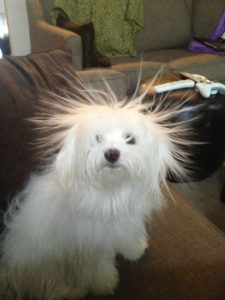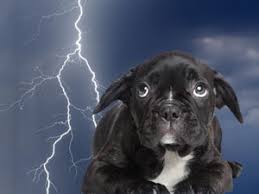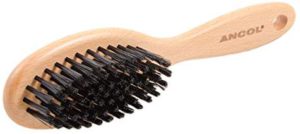Is your dog getting Zapped?
 Is your dog getting zapped like ours? Our little bichon x has had a problem for quite a while now. We knew he had skin problems as this breed of dog often has and we put it down to itchy skin. But we were wrong! He is prone to skin problem but that’s not the whole story.
Is your dog getting zapped like ours? Our little bichon x has had a problem for quite a while now. We knew he had skin problems as this breed of dog often has and we put it down to itchy skin. But we were wrong! He is prone to skin problem but that’s not the whole story.
Grooming Jazz
It occured to me a week or so ago, when I was grooming Jazz, that I was geting small electric shocks from him. Going by his reaction, he was also experiencing these shocks and we wasn’t a happy chappy! This is probably why he fidgets when being groomed.
Jazz’s symptoms
Looking back, Jazz had a regular tendency to jump suddenly and run around with his tail down and his back hunched. He would then lay down with his little ears back, looking behind. Sometimes he would turn and frantically bite at the root of his tail, or he would run off into the bedroom where his bed is. He would often stay there really still for quite some time, awake but not moving but looking around nervously, showing the whites of his eyes. This is a typical fearful look.
Moving slowly
I also noticed that if Jazz wanted to turn around in his bed, he would do it very, very slowly. I thought he must have a bad back or sore leg. What I have realised is that he is turning very slowly because of his fear of being zapped. Turning around and moving about when static is around, will likely induce a release of static charge. He had learnt that moving really slowly reduces the static effect. We have now changed his bed to one made of natural materials.
 Looks funny but…
Looks funny but…
This little Maltese may look funny and I know many owners purposely put static into their dog’s coat for a laugh. But have they ever thought it may be uncomfortable for their dog? He does not look too happy. His face shows an element of anxiety.
We don’t really know how static feels to our dogs. Some are probably more sensitive than others. Best be on the safe side and try and keep static to a minimum. Read the paragraph below about how thunderstorms affect our dogs.*
Then it came to me
This behaviour seemed to happen more in the winter so we thought it probably wasn’t fleas because they aren’t around so much in the colder months. Then I began to think. I often get electric shocks off the vacuum cleaner. This is a Dyson cordless cleaner with a plastic handle. I turned the light off once when I was vacuuming in the evening when it was dark. There it was, little sparks coming from the handle to my palm. It wasn’t that painful but to a little dog it could be very disconcerting.
So what is static?
A static electrical charge can increase through friction ie. contact between two insulating materials. Some materials hold static charge better than others. Insulating materials such as synthetics like plastic are a good example. They will discharge their static build up as soon as contact is made with a conductor. Such conductors could be metal doorknobs, the car handle is a prime example. For me, a shopping trolley often gives me a zap.
 A winter problem
A winter problem
Static electricity can be a problem all year round but it tends to get worse under dry conditions and in the winter months. Our warm homes often produce a dry environment, so static electricity will be more problematic in the winter. If both you and your dog retain static electricity, when you touch, that static will be discharged and both of you will feel it. Although there is no danger with static electricity, it can be disconcerting for you and your dog.
Static jumps the gap
Air is an electrical insulator and dry air will help a buildup of static. Water vapor in the air, however, conducts electricity nicely, allowing any charge that’s built up on our bodies to dissipate into the air. Colder air holds less water vapour so there is nowhere for a static charge to go. When a conductor is nearby, the static can actually jump the gap between the insulator and the conductor.
 *Thunderstorms and dogs…
*Thunderstorms and dogs…
Holistic pet therapist and author, Sally Morgan explains:
Static electricity. During a thunderstorm, static electricity in the clouds builds up, eventually bursting into lightning. Dogs can sense this static electricity, even from inside our homes, and often even before the storm reaches our own neighborhood, says Lazhar Ichir, Founder of Breeding Business, an educational platform for ethical dog breeders. “Specialists now understand that static electricity is felt by dogs through their fur, generating an unpleasant tingling sensation,” he says. “For this reason, pets feel agitated and seek a spot they hope might isolate them from the static charges.”
The problem with synthetics
So why is this happening in our home? Well, we actually have a fitted carpet which is made of synthetic fibres. These synthetic carpets can harbour static electricity and give you a zap, especially if you’re wearing synthetic fibre socks, slippers or shoes. I walk about in socks at home, so I bought socks made from bamboo, a natural material. With those socks on, I don’t get zapped at all.
Nylon brush and comb
So what about poor Jazz? The first thing I did was change his comb and brush. I noticed that when using a nylon brush and comb, his hair would produce static. His tail would stand on end, the same as if you rubbed a balloon on your hair to make it statically charged.
 Changed to wooden brush
Changed to wooden brush
I bought a wooden brush with natural bristles and a stainless steel comb. That made a difference straight away but I wanted to make sure it didn’t happen again.
Short hair cut
Jazz’s hair is like a poodle, very soft, very fine, very dense. This is why I was getting zapped, as was he. His hair was quite long and easily held a static charge. It just didn’t occur to me that he was feeling this static. It must have been very upsetting for him. So, I gave him a shorter hair cut. What a difference!
Stop the zapping with these tips
- If the problem is severe, introduce a humidifier into the home when the central heating is on in the winter. This will increase moisture content and reduce the likelihood of static shocks.
- Artificial materials will induce static electricity. If you put clothes on your dog ie. a coat or jumper for warmth, made sure they are of natural fibres such as cotton.
- Some dog blankets will be made of synthetic fibres as are some dog beds. Choose a bed or blankets that are made from natural materials.
- Make sure you yourself are not producing static. Try cotton or other natural materials, especially for your socks. Bamboo fibres make really soft socks and comfortable clothes.
 Make sure your hands are not dry by regularly using a moisturiser on them, especially when dealing with your dog.
Make sure your hands are not dry by regularly using a moisturiser on them, especially when dealing with your dog.- Buy a wooden brush with natural bristles for your dog’s coat. Use a stainless steel comb. Try to avoid nylon or plastic brushes and combs.
- You can buy anti-static sprays. Or you could try a fine spray of water over your dog’s coat a few times throughout the day.
- As for thunderstorms, it has been suggested relaxing music, putting your dog in the bath, (that’s if he likes baths), spraying him with a fine mist of water, putting him in a dark room. You could buy him an igloo bed to hide in and they’re warm. Larger ones are on the market now.
Have you any tips?
If you have any experiences with your dog and static electricity or tips on how to eliminate it, please share them with other readers by leaving a comment. Thanks for reading!

Well, I never thought dogs could have a problem with static, but it makes sense, I guess dogs might have also some bad hair problems!
Poor dogs, and this might happen to long hair dogs and some dogs have thinner hair than others so this might be also a big problem for them too.
When my sister called me the other day to ask me what she could do as her dog was having a bad day with its hair, I didn’t believe this could happen to dogs, but after reading your article, I can tell my sister there is a problem and your article will help her to make some changes, like getting a wood brush for his dog and check if the atmosphere in her place is too dry or not.
I will forward your article to my sister, and I’m sure she will find it helpful and interesting.
Thanks for your comment Alejandra. If your sister’s dog is having fly away hair, it could mean static. I’m sure she will find this post helpful and informative.
Hello Ches,
I have a Bichon-Shitzu, and he has been acting up lately. I read your article about ‘Mastering the Walk’, and found it very helpful. Yes, he needs exercise and mental stimulation.
We have also had issues with him pulling on the leash when we go for a walk, and we have been taking a course called, ‘Polite Pooches’ the last few weeks. The trainer there told us that the retractable leashes will almost always lead to your pet pulling on the leash. Would you say this is true?
We have switched to a regular leash, and have found it to be a bit better, but he still pulls. Are there any other ways we can teach him to walk with us instead of dragging us around?
Thanks,
Michael
Hi Michael and thanks for your comments and questions. The trainer is right, retractable leads are no good if you’re training a dog to be good on the lead. They are good off road and in an environment where you want to give the dog a little freedom when it would be unsuitable to let him off the lead. Don’t EVER use a retractable lead near traffic. So many accidents have occured, some fatal!
First get your dog to follow you in the home. Put his lead on and walk around the house and garden. He is less likely to pull in his home environment. If he walks nicely give him plenty of praise and/or a treat. If he pulls stop. Walk on in another direction. Have him guessing which way you will go next.
Don’t let your dog leave the home in an excited state. Once excited, it is difficult to bring them back to calm. Training is not quick, you need to be patient and not be worrying about time. Wait until you have free time with no engagements. Once you have your dog walking nicely with you at home and in the garden, progress to a quiet area or back street. If he starts to pull, stop, start, change direction. Don’t let him pull you to where he wants to go. He must learn that the more he pulls, the longer it will take to get there. He must learn to follow you, not the other way around! Even if it means you only walk a few yards, be patient. If he does walk nicely even for a few seconds, praise him immediately. Sometimes, try turning into him rather than away from him. This will get his attention on you. He will likely look up at you, a good sign!
Above all, be patient and don’t get frustrated. Be calm but at the same time assertive. He will not walk well unless he considers you to be in charge of the walk. Walk tall and don’t look down at him. You can feel what he’s doing by the leash. Walk slowly, then walk faster. Stop. Turn around and walk in the other direction. Stop. Turn left. Slow down. Make up your mind he will never pull again. If he pulls towards another dog, turn around and go the other way. He only meets another dog when he is not pulling or excited.
Are you in the UK?
This was profoundly insightful. You’re pretty great at storytelling. You got me captivated till the very end. And the tips at the end with recapped and some added extra advice were exactly what I needed.
Truth told I had no idea dogs can feel thunderstorms like that. Or can be made so incredibly uncomfortable by them. To an extent, isn’t this like a self-preservation tool that they’ve always had available to them and so that they could effectively avoid storms (and evolutionary improve their survivability)? In that regard, I can’t help but wonder what kind of other adaptations various animals use to somewhat predict terrible weather and that kind of thing.
Also, I really enjoyed the bit where you went sort of scientific about how and why static happens. To me, it helped profoundly to better understand why we ourselves are at times zapped. I, for example, have a sweater that I almost always (and touche, especially in winter) get zapped in.
I really appreciate all the insight! Cheers. <3
Matiss
Hi there Matiss and thanks for reading the post. I think you’ve hit the nail on the head when you suggest it may be a self-preservation tool. Thinking about it, a thunderstorm could cause all kinds of problems for animals and dogs in the wild. There could be floods, there could be bush fires. This is perhaps why animals that seem to know when a serious natural event is about to happen, take flight! Earthquakes come to mind too.
I’m please you found the article informative and you’ve certainly got me thinking with your theory about mother nature giving animals this tool for self protection. Great stuff!!
Howdy! Someone in my Facebook group shared this site with us
so I came to look it over. I’m definitely
loving the information. I’m book-marking and will be tweeting this to my followers!
Great blog and amazing design and style.
Thanks for the comments Cory. This website has not been added to recently because of the last 4 difficult years. I will be adding more information in the near future.